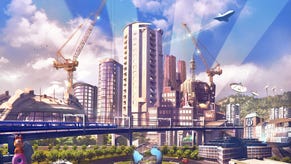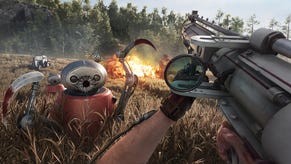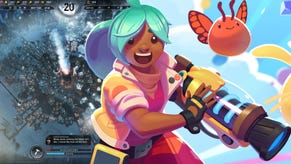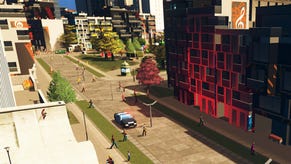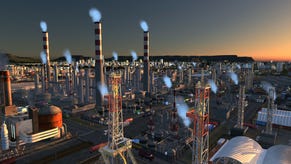A Cities: Skylines Succession Diary, Part 2: Necropolis
The Mayor Who Killed 1,600 Residents
Continuing a series in which players take it in turns to manage and build up one Cities: Skylines settlement, passing the savefile onto the next person whenever the city levels up. Joining me in this endeavour are Jonathan Shipley and Dan Corns.
When last we left you, we foretold an apocalypse. Here's how The Brown Plague took 1,600 lives and very nearly killed the entire city.
DAY 4 (part two): Judge Death
Jonathan: I’m overstating the seriousness of the situation.
Everyone didn’t die. That would be absurd. Imagine if, in a completely healthy and otherwise prosperous town of 1,900 people, everyone died. Very quickly. That would be ridiculous. This is the 21st century. We have medical centres. We have ambulances. We have advanced technology for ensuring that our water supplies remain clean and drinkable.
Ahem.
I was fiddling about with the garbage system and one way roads, towards the end of my tenure. Things were going well. I was zoomed in to the map, making subtle adjustments so I wasn’t really paying attention to the rest of the town. I did notice that Chirpy kept tweeting annoyingly about something, but my mind was elsewhere. I was Isambard KingdomBrunel, building an infrastructure that would be admired for centuries. I could take my eye of the ball for a moment.
[TIP: Never, ever, no matter how confident you are, play this game in triple speed. You will miss things.]
So, it turns out I wasn’t Brunel, I was Albert Speer. I scrolled up. Lots of sick faces. LOTS of sick faces. Like, everywhere. I don’t know how my fellow mayors respond to crisis situations. Perhaps they do the sensible thing; press pause and calmly try to get to the root of the problem. Not I. I screamed and began hurriedly plonking medical centres randomly on the map. I looked at the health meter.
Apparently general health in the city was at 1%. I had provision for healing 100 people and there were 915 sick. The new medical practices took me up to healing 300 people. I looked at the number that were sick. It seemed to be slowly going down. That was good.
I looked at Chirpy, who had, it turned out, been trying to tell me that there was a severe case of microbial flora in the water supply and that things were very serious. I flipped down to the water view and cursed; I couldn’t see what the problem was. I had just moved the drain pipe right across the other side of town from the water supply, so it couldn’t be that. For safety, I quickly moved the water supply to a fresh place along the river.
I went back to my health meter. Only 400 sick now. Thank god. That must mean that I’d cured over half the ailing patients. Things were getting back under control.
Then I looked at our population.
It was 700 people. 1,200 people had either died or moved out. I screamed again and flipped back to the health meter. Number of people ill… 700 people. I swiftly worked out that my entire population was dying. If the medical centres really were healing people, they were getting sick again right away.
WAS THIS AIRBORNE?
By now my screaming was as regular and unexceptional as a seagull’s screech on Brighton seafront. I couldn’t figure out the problem. I began randomly flipping through the data views until I arrived at pollution.
Hey, I thought. Landfills make a lot of pollution, don’t they?
And then I saw the water tower. Earlier on I’d been doing some reorganising and I moved my garbage down from the Lower East Side to a bit of land by the highway. Then I’d reorganised some land by the residential zone. And…
And I’d dragged the water tower out of the way, hadn’t I?
Well. Don’t build water towers near landfill. It had thoroughly corrupted my water supply and killed over a thousand people. I quickly demolished it and zipped back to the health bar. Still 600 sick and my four medical centres were seemingly unable to get them back to full health. I tried to build two new doctor’s surgeries and that’s when I noticed our finances. By now The Room was 80k in debt. Population was 616 now, and fading fast. Every single business had sold up and left town. I couldn’t see any way of making money. I considered snapping the computer off and stalking off to the pub in shame.
Reader, I fixed it. Somehow. The first thing I did was to pull the budget back to 50% for every service I could (police, fire, garbage). Then I zoned for a whole lot of new residential land, as at least I knew the water supply was now OK - the problem was healing the sick not more disease.
Somehow, despite every business closing up, the demand bars showed there were still people willing to move in. And they began to, and my weekly outgoings slowly crept back towards the black. Now I plunged my healthcare funding up to 150% and zoomed in to watch the ambulances carting people in and out of the medical centres.
I looked away every time I saw a hearse roll past. Back into the red.
Now there were only 500 people sick. Then 400. Then 300. I began demolishing excess medical centres and zoned for more houses. A couple of lights came back on in the vacant industrial heartland. Our population began to rise. I noticed that I was absolutely exhilarated – two hours had passed and my heart was thudding. 1,600 people had died.
I began laughing. It was a kind of grief, I think.
Cities Skylines is an absolutely brilliant game.
DAY 5: Complacency
Dan: Well, I must admit I was a little apprehensive on returning to the city I had help grow having listened to Jonathan’s horror stories of how HE nearly killed the entire population through plumbing error.
Jonathan had constructed a motorway and Alec an industrial district, which since the plumbing fiasco had helped resuscitate the city. I’m never too keen on industrial zones. I see them as a necessary evil to be hidden away behind lines of trees, so I’m glad Alec did the ground work on this one. Rubbish disposal was also sorted, leaving me to enjoy the fruits of their labour.
And, not wishing to blow my own trumpet - I did wonders. Demand for Residential and commercial properties were through the roof when I signed off having reached ‘Busy Town’ status.
I was disappointed that my colleagues had filled in the gaps I had left for future rail expansion into the heart of the city so I corrected their short term vision by bulldozing the housing they had put there and bringing the gaps between districts back - they’ll thank me when we have rail easily running throughout
I extended a pleasant estate - now called East side, which maximises usable land space between roads and planted trees in the few gaps. The road system I think is a liveable but efficient one. There are too many unnecessary roads in other parts of the city with very few blocks for building between them.
I built a bus station and created a popular route around the city. I also built a school and fire station. I then extended the motorway to a new district christened ‘New Dansville’ based on a roundabout and near the coast. I hope the motorway isn’t overcome with junctions - slowing its flow.
I'm proud to say that one thing we've agreed on is that the city should keep its green credentials, so I built more wind turbines.
Time to turn the savefile over to Alec. I know Jonathan is more of a micro manager than me on this game; I’ve concentrated on the macro image and didn’t look too closely at individual traffic snare ups and such. However, I think I bequeath our growing city in good health.
On page two: Oh no he didn't. And welcome to The Weedabout
DAY 6: The Weedabout
Alec: First order of business was fixing everything Dan got wrong. Power shortages, big areas without water, major districts garbage trucks couldn’t reach… I also discovered that someone had mysteriously set the city’s spend on water and sewage down to just 64%, which explained why our residents had been generating a small country's worth of excrement for so long. There was no-one manning our many pipes; there was a backlog of logs. It's a miracle anyone had survived The Brown Apocalypse. Dan had lured people in well enough, but I had little doubt that they were in a living hell.
So I fixed all that, then I filled in all the space he’d left for railways as punishment for his poor micro-management.
I decided this wasn’t punishment enough, so I legalised recreational drugs in New Dansville and renamed it ‘The Weedabout.’
I also gave it free public transport in order to attract more tourists to witness his Ozymandias moment.
I decided this still wasn’t punishment enough, so then I built this just outside The Weedabout:
Then I felt a bit guilty for picking on Dan, so I created a new district for the corner of town we kept our increasingly full landfills in.
Karmic balance is restored. I am sure that there will be zero consequences for my entirely justified actions.
With these important tasks completed, I decided it was time to put the brakes on expansion for a while and concentrate instead of improvement. As beautiful as crude vitriol spelled out in trees was, I felt that this was not yet an appealing place to live. I didn’t want to simply gloss over The Room’s dark history, however, so the first thing I built was this Monument to Death, right off the highway exit, in order that no visitor could possibly forget what a necropolis this place once was.
Next, I wanted to make the roads less of an ey- and earsore. Given our limited funds we’d built the whole town around basic roads, which created noise pollution as well as making the whole place look like a giant car park. So I merrily upgraded everything I could to tree-lined streets - this would raise happiness and land value, and those poor shmoes we’d stuffed right in the middle of heavy industry and highway junctions would hopefully no longer be wishing they too were taken in the great Shit-Plague Of Turn 4. (Really, a whole lot of bulldozing was required, but I don’t think any of us have the will just yet).
I made a huge mistake. I had one way roads selected. A large portion of the city is now exclusively one-way roads. Where do they go? How do you join them? Can you ever leave them? I was afraid. Too afraid to look closely. So I ran. Maybe it will be OK?
From thereon in I spent most of my time tinkering with The Weedabout, which had been spared this one-way blight. I upgraded roads, added in a few parks and special buildings, and then built the world’s most excessive garbage van route. This area was ill-served by refuse collection, due to being a million miles from anywhere and Dan’s bizarre concentric one-way roundabout layout, but I didn’t want to start a second landfill site - Jonathan’s House had more than enough capacity for the city’s waste. So, yeah, I did this.
It’s an expensive band-aid over a spurting arterial wound, but it did solve the problem. By not zoning anything along that road, no-one other than dump trucks ever uses it. No more garbage pile-up, no more trucks braving the labyrinthine city centre one-way system just to go collect The Weedabout’s mountain of empty Rizla packets.
With money trickling in nicely I built a few more special buildings and parks around town, finally giving the populace something to do other than work and get high. I also decided that someone should benefit from the coastline before we fully littered it with windfarms, so I built a road right down to the beach, then zoned room for just one home. These are the luckiest guys in town, and also the most hated.
With the city looking a whole lot prettier (and hopefully a whole lot more valuable), it was finally time to open the doors again. I built vast new residential zones in The East Side and a new strip mall between it and the industrial area. Ready for the population influx, I also set up a prospective new farming district. Jonathan’s tiny, restricted-access forestry zone was failing, and I found myself bulldozing abandoned buildings there regularly, so perhaps our fortune would instead lie in livestock.
Big Town time. And big squabbles ahead, I think.
You can download our savegame as it was by the end of this turn here. Yes, there are A HUNDRED MILLION THINGS WRONG with it.














